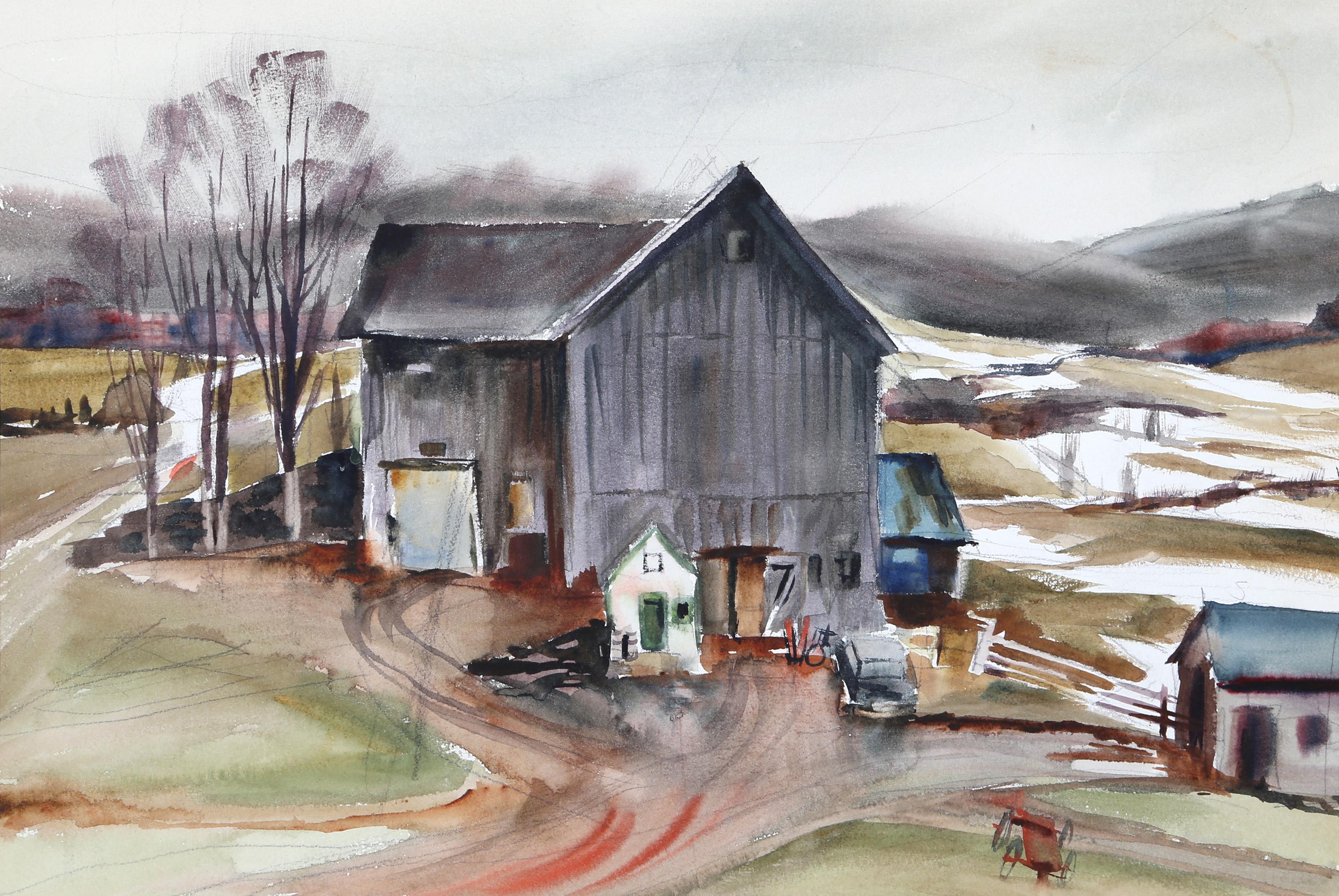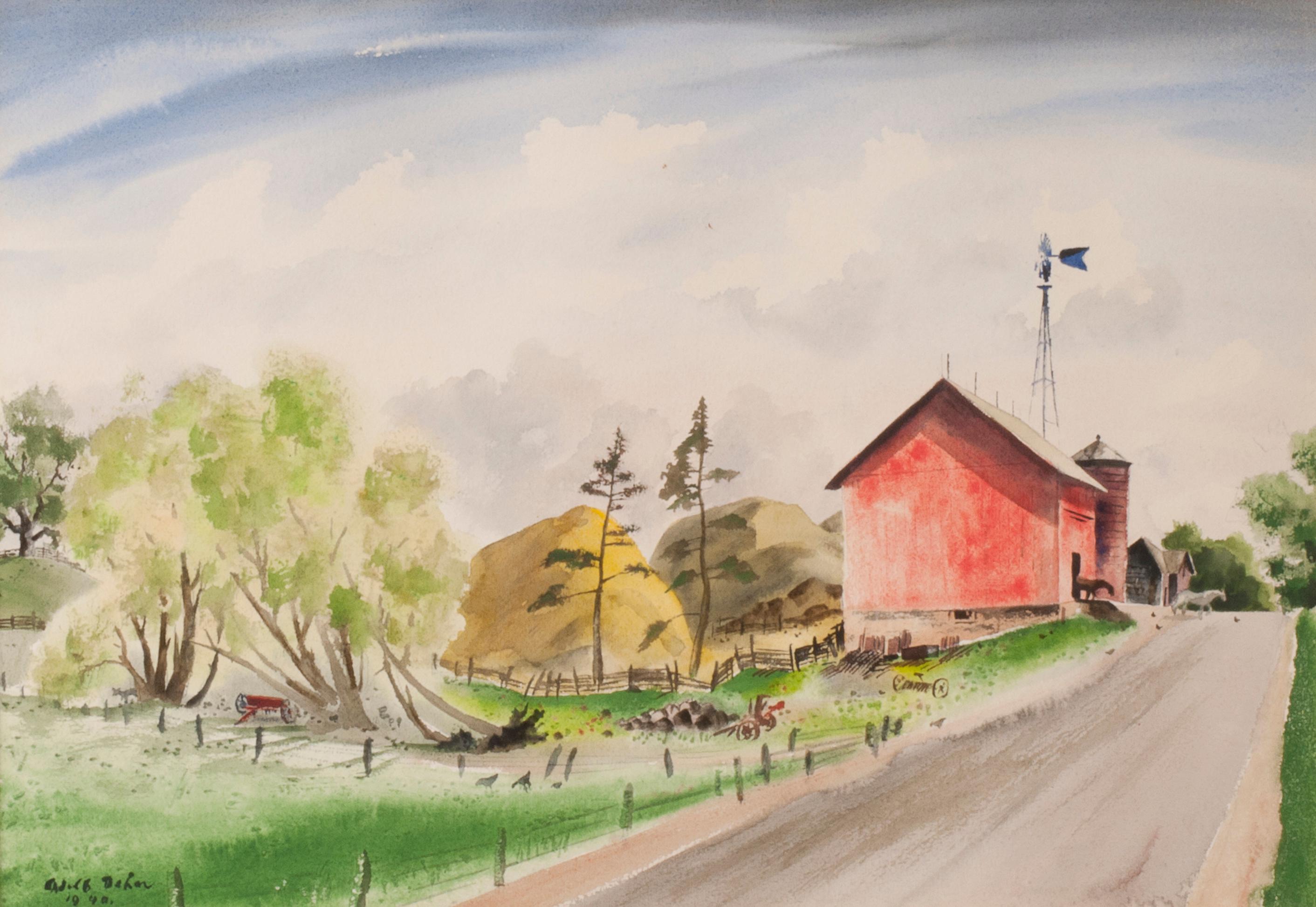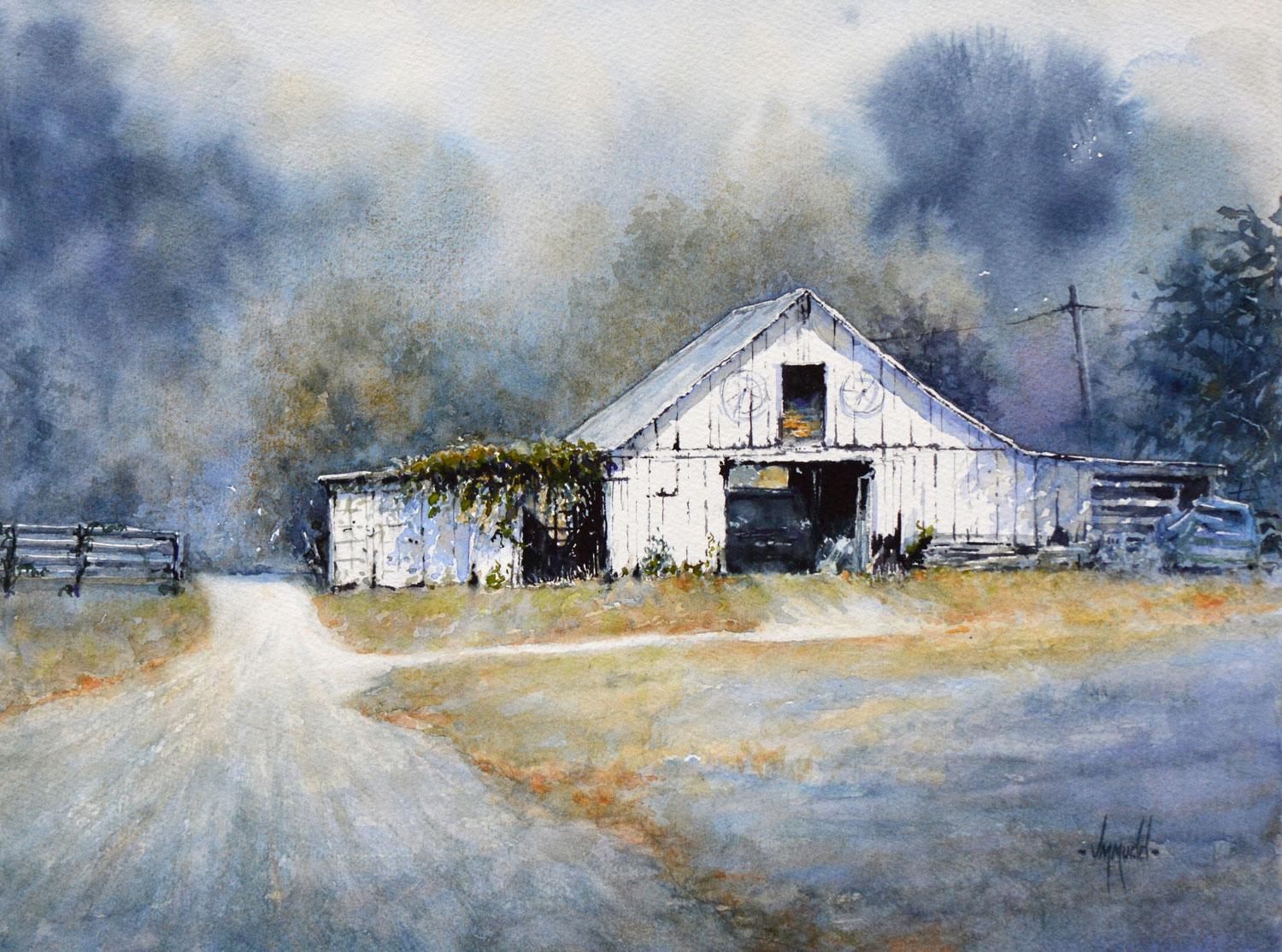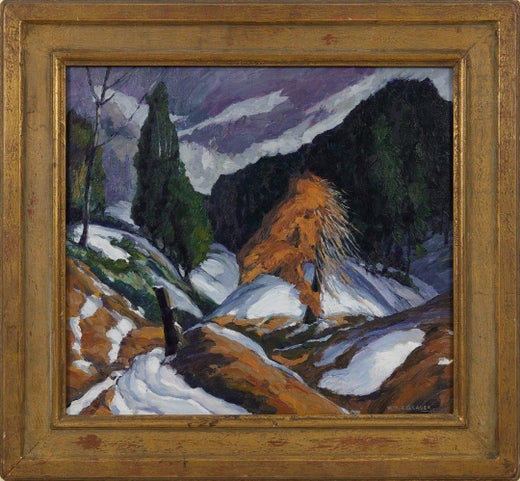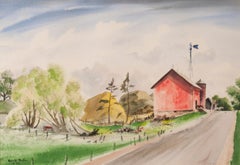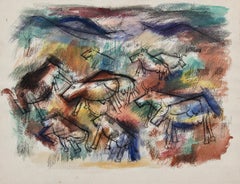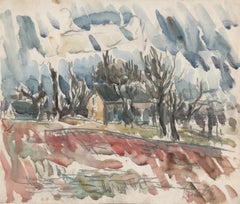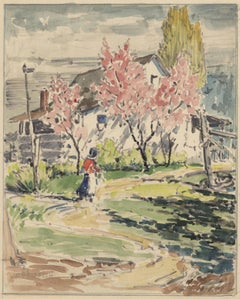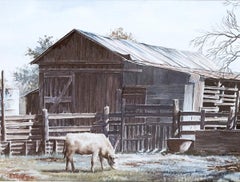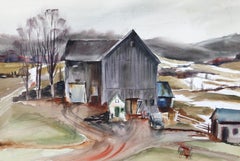Items Similar to untitled (The White Barn with Farmers and Horse)
Want more images or videos?
Request additional images or videos from the seller
1 of 9
William Graueruntitled (The White Barn with Farmers and Horse)
$2,500
£1,915.95
€2,202.04
CA$3,511.37
A$3,929.87
CHF 2,057.15
MX$47,740.85
NOK 26,120.56
SEK 24,649.21
DKK 16,431.13
About the Item
untitled (The White Barn with Farmers and Horse)
Watercolor, c. 1950
Signed by the artist in ink lower right: Wm. C. Grauer
Numbered in pencil verso: 152
Provenance:
Estate of the Artist
Gretchen Grauer Vanderhoof, the artist's daughter
Condition: Excellent
Image/Sheet size: 18 3/4 x 24 inches
William C. Grauer (1895-1985)
William C. Grauer (1895-1985) was born in Philadelphia to German immigrant parents. After attending the Philadelphia Museum School of Industrial Art, Grauer received a four year scholarship from the City of Philadelphia to pursue post graduate work. It was during this time that Grauer began working as a designer at the Decorative Stained Glass Co. in Philadelphia.
Following his World War I service in France, Grauer moved to Akron, Ohio where he opened a studio in 1919 with his future brother-in-law, the architect George Evans Mitchell. Soon, the Rorimer-Brooks design company, the developer Van Swerngen brothers, as well as the Sterling Welch and Halle Bros. department stores realized the extent of Grauer's talent and eagerly employed him. Grauer’s work during this time included architectural renderings for Shaker Square, Moreland Courts, and other many other projects commissioned by Cleveland architects. Grauer also remained true to his roots as a master designer of stained glass windows. With his work in such high demand, Grauer received a commission in 1921 to paint murals for the French Grill Room of the Kansas City Club. Later, he also worked for the Cleveland Builders Exchange in 1928.
In the 1920s, Grauer had a studio in the Old Fine Arts Building in Cleveland, where he met his future wife and fellow Philadelphian, Natalie Eynon Grauer, whom he married in 1924. After creating murals for the Greenbrier Hotel in White Sulfur Springs, West Virginia in 1932, together Grauer and his wife founded and co-directed the successful Old White Art Colony, School and Gallery, which they continued to frequent during the summer months in the 1930s and 1940s. Grauer’s involvement in West Virginia also included his West Virginia murals for the West Virginia exhibitions at the 1933 Century of Progress Exhibition in Chicago and the 1939 World’s Fair in New York City.
Back in Ohio, Grauer became affiliated with Cleveland College, one of the component colleges of Western Reserve University, which later became Case Western Reserve University. According to Jill Tatem, assistant university archivist with Case Western Reserve University, Grauer was a lecturer in art at Cleveland College from 1934 to 1948, associate professor of art from 1948 to 1966, and then an associate professor emeritus. Following the death of his wife in 1955, he married another Cleveland College art instructor, Dorothy Turobinski, in 1964. After Grauer retired from Western Reserve University in 1966, he continued to paint and teach privately until his death in 1985 at age 89.
Grauer's work is in the collections of numerous Museums including The Cleveland Museum of Art, the Whitney Museum of American Art in New York, and the Smithsonian Institution in Washington D.C.
- Creator:William Grauer (1896 - 1985, American)
- Dimensions:Height: 18.75 in (47.63 cm)Width: 24 in (60.96 cm)
- Medium:
- Movement & Style:
- Period:
- Condition:
- Gallery Location:Fairlawn, OH
- Reference Number:Seller: FA76871stDibs: LU14016518912
William Grauer
William C. Grauer (2 Dec. 1895-6 Apr. 1985) was a painter, muralist, and art teacher active in Cleveland for nearly 60 years. Born in Philadelphia, he graduated from the Pennsylvania Museum School of Industrial Art in 1914 and saw service in France during World War I. Coming to Cleveland as a free-lance artist in 1927, he married Natalie Eynon (1888-1955), a fellow native Philadelphian and artist with whose career his own became intertwined. Invited to contribute murals to the President's Cottage at White Sulphur Springs, W. Va., in 1932, they returned to found and co-direct the Old White Art Colony, School and Gallery there during the summers from 1934-40. During the same period they also started the art department at Cleveland College of Western Reserve University. Grauer painted murals for the West Virginia exhibitions in both the Chicago Century of Progress (1933) and the New York World's Fair (1939). Residents of Ambleside Dr. near University Circle, the Grauers also maintained a summer home and studio in E. Claridon, Geauga County. They had 2 daughters, Blanche E. and Gretchen. Following the death of his wife, Grauer married another Cleveland College art instructor, Dorothy Turobinski, in 1964. He retired from WRU as associate professor of art in 1966 but continued to paint and to teach privately. Increasingly abstract in style in his later years, his work had been exhibited in 55 May Shows at the Cleveland Museum of Art.
About the Seller
5.0
Recognized Seller
These prestigious sellers are industry leaders and represent the highest echelon for item quality and design.
Gold Seller
Premium sellers maintaining a 4.3+ rating and 24-hour response times
Established in 1978
1stDibs seller since 2013
802 sales on 1stDibs
Typical response time: <1 hour
Associations
International Fine Print Dealers Association
- ShippingRetrieving quote...Shipping from: Fairlawn, OH
- Return Policy
Authenticity Guarantee
In the unlikely event there’s an issue with an item’s authenticity, contact us within 1 year for a full refund. DetailsMoney-Back Guarantee
If your item is not as described, is damaged in transit, or does not arrive, contact us within 7 days for a full refund. Details24-Hour Cancellation
You have a 24-hour grace period in which to reconsider your purchase, with no questions asked.Vetted Professional Sellers
Our world-class sellers must adhere to strict standards for service and quality, maintaining the integrity of our listings.Price-Match Guarantee
If you find that a seller listed the same item for a lower price elsewhere, we’ll match it.Trusted Global Delivery
Our best-in-class carrier network provides specialized shipping options worldwide, including custom delivery.More From This Seller
View AllHorses Leaving the Barn
By Adolf Dehn
Located in Fairlawn, OH
Horses Leaving the Barn
Watercolor on paper, 1940
Signed and dated lower left corner (see photo)
Condition: Excellent
Image: 14 1/2 x 21”
Frame: 25” x 31”
Provenance; Associated American Artists, New York (see photo of label)
Mamdouha and Elmer Holmes Bobst
Displayed in an original wormy chestnut frame with OP3 Acrylic. Most probably from the AAA Dehn watercolor exhibition of 1940. Vintage original framing chosen by the artist.
Note: Elmer Holmes Bobst (1884–1978) was an American businessman and philanthropist who worked in the pharmaceutical industry. His wife, Mamdouha, was also well known philanthropist.
Bobst was born in Lititz, Pennsylvania. He aspired to become a doctor, but instead, he taught himself pharmacology. After his wife Ethel composed his interview letter, he became manager and treasurer of the Hoffman-LaRoche Chemical Works by 1920. When Bobst retired from the company in 1944, he was one of the nation's highest paid corporate executives. In 1945 he took charge of the ailing William Warner Company (later Warner–Lambert) and he remained board chairman until his retirement.
Bobst had close connections to President Dwight Eisenhower, but was also a close friend of President Richard Nixon.
Note: In 1940, the year of this watercolor, Dehn and Elizabeth Timmerman visited Waterville, MN on their way to Colorado Sprint, Colorado where Dehn was to teach lithography and watercolor. This watercolor is obviously a view of the area around Waterville.
Adolf Dehn, American Watercolorist and Printmaker, 1895-1968
Adolf Dehn was an artist who achieved extraordinary artistic heights, but in a very particular artistic sphere—not so much in oil painting as in watercolor and lithography. Long recognized as a master by serious print collectors, he is gradually gaining recognition as a notable and influential figure in the overall history of American art.
In the 19th century, with the invention of the rotary press, which made possible enormous print runs, and the development of the popular, mass-market magazines, newspaper and magazine illustration developed into an artistic realm of its own, often surprisingly divorced from the world of museums and art exhibitions, and today remains surprisingly overlooked by most art historians. Dehn in many regards was an outgrowth of this world, although in an unusual way, since as a young man he produced most of his illustrative work not for popular magazines, such as The Saturday Evening Post, but rather for radical journals, such as The Masses or The Liberator, or artistic “little magazines” such as The Dial. This background established the foundation of his outlook, and led later to his unique and distinctive contribution to American graphic art.
If there’s a distinctive quality to his work, it was his skill in introducing unusual tonal and textural effects into his work, particularly in printmaking but also in watercolor. Jackson Pollock seems to have been one of many notable artists who were influenced by his techniques.
Early Years, 1895-1922
For an artist largely remembered for scenes of Vienna and Paris, Adolf Dehn’s background was a surprising one. Born in Waterville, Minnesota, on November 22, 1895, Dehn was the descendent of farmers who had emigrated from Germany and homesteaded in the region, initially in a one-room log cabin with a dirt floor. Adolf’s father, Arthur Clark Dehn, was a hunter and trapper who took pride that he had no boss but himself, and who had little use for art. Indeed, during Adolf’s boyhood the walls of his bedroom and the space under his bed were filled with the pelts of mink, muskrats and skunks that his father had killed, skinned and stretched on drying boards. It was Adolf’s mother, Emilie Haas Dehn, a faithful member of the German Lutheran Evangelical Church, who encouraged his interest in art, which became apparent early in childhood. Both parents were ardent socialists, and supporters of Eugene Debs...
Category
1940s American Realist Landscape Drawings and Watercolors
Materials
Watercolor
Cows in a Field (Recto) Two Figures in an Interior (Verso)
By Louis Schanker
Located in Fairlawn, OH
Cows in a Field (Recto)
Two Figures in an Interior (Verso)
Watercolor on heavy textured paper, 1938
Signed in ink verso image of Two Figures, unsigned ...
Category
1930s American Modern Landscape Drawings and Watercolors
Materials
Watercolor
Landscape with buildings and trees
By Leon Kelly
Located in Fairlawn, OH
Landscape with buildings and trees
Watercolor on paper, c. 1930's
Signed in pencil lower right (see photo)
Provenance: Estate of the artist
Condition: Excellent
Sheet size: 9 3/8 x 1...
Category
1930s American Modern Landscape Drawings and Watercolors
Materials
Watercolor
Spring Landscape with house and figure
By Louis Oscar Griffith
Located in Fairlawn, OH
Spring Landscape with house and figure
A preliminary watercolor for a color aquatint, illustrated on line, title unknown
Signed lower left in block letters (see photo)
Watercolor and...
Category
1920s American Impressionist Landscape Drawings and Watercolors
Materials
Watercolor
Horses in Stable
By Georges Lemmen
Located in Fairlawn, OH
Horses in a Stable
Black chalk on tan wove paper, 1896
Signed with the estate stamp lower right corner
(see photo)
Note: The image has been sqaured off in red chalk grid lines for use in a large painting
Dated in charcoal lower right: "23 Nov '96"
Condition: Tack holes in the corners
small tears and creases along margins
Sheet size: 14 11/16 x 16 13/16 inches
Provenance: Dr. Ernst Hauswedell
Brenner Fine Arts, Inc., New York
Alan Stone Gallery, New York
"Georges Lemmen was the son of an architect and studied under Amédée Bourson at the academy in St Joost-ten-Node. He was invited in 1889 to join the Group of Twenty ( Cercle des XX) which had been launched in 1884 by Oscar Maus and had in the interim emerged as an influential force in Belgian artistic circles, not least by bringing to public and critical attention the work of such artists as Georges Seurat and Paul Signac. The Cercle des XX would be reborn in 1894 as La Libre Esthétique.
In the early days of the Cercle des XX, Lemmen espoused a pointilliste technique. His earlier painting was clearly influenced by the Neo-Impressionists; over time, however, his style became more subtle and nuanced – recalling, perhaps, that of his compatriot Van Rysselberghe, another Cercle des XX member. With the group’s rebirth as the Libre Esthétique, Lemmen’s work became more intimiste in character, most notably in his portraits, nudes and still-lifes, where the influence of Bonnard and Vuillard is unmistakable, as is that of Renoir, particularly after Lemmen’s travels in the Midi in 1911. From this point onwards, he would go on to make a major contribution to the renewal of the graphic and decorative arts in terms of his input to the new ‘free’ aesthetic and to Art Nouveau. Although his draughtsmanship retained its essential purity and elegance of line, his painting became more fleshy, imprecise and sensual, his compositions governed less by technical considerations than by the urgent need to express his emotions.
Between 1889 and 1893, Lemmen exhibited at the Salon des Indépendants in Paris, aligning himself with the Neo-Impressionists. In 1893, Henry van de Velde invited him to participate in the Pour l’Art association that had been created in Antwerp. He travelled to the south of France in 1911. By this juncture, he had already exhibited solo on two occasions (in 1906 and 1908) at the Galerie Druet in Paris. A further solo exhibition in 1913, his first in Brussels, cemented Lemmen’s reputation.
Museum and Gallery Holdings
Bremen (Kunsthalle): Standing Nude Combing her Hair
Brussels (Mus. royaux des Beaux-Arts de Belgique): Children’s Room (watercolour); Reading; Couture; Young Girl by the Sea...
Category
1890s Impressionist Animal Drawings and Watercolors
Materials
Chalk
untitled (Hillside in Spring)
By William C. Grauer
Located in Fairlawn, OH
untitled (Hillside in Spring)
Gouache on paper, c. 1965
Signed with the estate stamp lower right
Provenance: Estate of the artist
by decent
William C. Grauer (1895-1985) was born in Philadelphia to German immigrant parents. After attending the Philadelphia Museum School of Industrial Art, Grauer received a four year scholarship from the City of Philadelphia to pursue post graduate work. It was during this time that Grauer began working as a designer at the Decorative Stained Glass Co. in Philadelphia.
Following his World War I service in France, Grauer moved to Akron, Ohio where he opened a studio in 1919 with his future brother-in-law, the architect George Evans...
Category
1960s Realist Landscape Drawings and Watercolors
Materials
Gouache
You May Also Like
"Barn and Grazing Cow" Western Watercolor Scene
Located in Austin, TX
A western watercolor depiction of a farm with a cow grazing in front of a brown barn. Created by Rick Morris Patterson, measuring 21" x 29".
Category
20th Century Landscape Drawings and Watercolors
Materials
Watercolor, Archival Paper
Earl Scwaiger's Barn
Located in San Francisco, CA
This artwork titled "Earl Scwaiger's Barn" c.1980 is a watercolor on paper by American artist W. Ralph Murray, 1932-2009. It is signed at the lower righ...
Category
Late 20th Century American Impressionist Landscape Drawings and Watercolors
Materials
Watercolor
Large Barn, Impressionist Watercolor by Eve Nethercott
By Eve Nethercott
Located in Long Island City, NY
Eve Nethercott, American (1925 - 2015) - Large Barn (P2.44), Year: 1961, Medium: Watercolor on Paper, Image Size: 13.5 x 20 inches, Size: 15 x 22 in. (38.1 x 55.88 cm), Descr...
Category
1960s Impressionist Landscape Drawings and Watercolors
Materials
Watercolor
Farm at Stover Mill, Bucks County, Pennsylvania, Regional American Landscape
Located in Doylestown, PA
Stover Mill is an American regional landscape of a historic mill and farm in Bucks County, Pennsylvania by local resident and artist Loraine Thompson. The 10.5 x 13.5 inches watercol...
Category
Early 2000s American Realist Landscape Drawings and Watercolors
Materials
Watercolor, Archival Paper
The White Barn, Original Painting
By Judy Mudd
Located in San Francisco, CA
Artist Comments
A rustic white barn stands in quiet solitude, its weathered walls telling a story of the past. A dirt path winds toward a misty, atmospheric backdrop. The sof...
Category
21st Century and Contemporary Impressionist Interior Drawings and Waterc...
Materials
Watercolor
Countryside Barn Watercolor by Abraham Soffer
Located in New York, NY
Abraham Soffer (American, 1922-2004)
Untitled, c. 21st Century
Watercolor on paper
Sight: 6 3/4 x 9 1/2 in.
Framed: 11 3/4 x 14 3/4 x 3/4 in.
Signed lower right: A. Soffer
Abraham S...
Category
21st Century and Contemporary Contemporary Landscape Paintings
Materials
Watercolor
More Ways To Browse
William West
1920s French Drawing
War Horse
1940s French Drawings
Architectural Rendering
Spring Landscape Watercolor
White Barn
1964 Worlds Fair
The Horse Fair
French Barn
American Barn Paintings
Vintage Barn Signs
George Post Watercolor Paintings
George Post Watercolor
Old Barn Painting
Horse And Western Paintings
Horse Painting Old Masters
Four Horse Paintings

